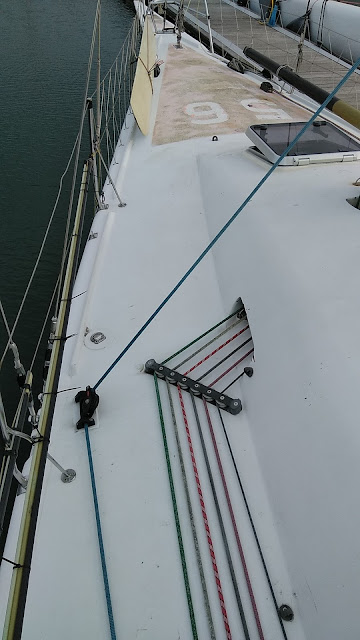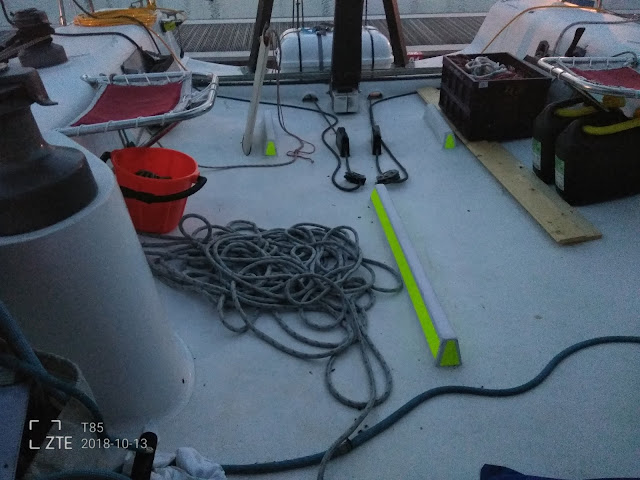A few more jobs checked off the list.
Some nice work from Mike at Strongrope Rigging to make up some aft backstays, runners, checkstays and inner forestay. The Dyneema Dux is covered with dyneema silver-grey braid to minimise chaffe and prolong life of the stays. All stays are lashed to the past fittings and terminate to one running backstay trim line. The checkstays have a low friction ring s to accommodate the stay deflectors. The inner forestay has a Colligo lower fitting for deck tensioning.
Please join me as I breathe life back into this great 1997 Lutra Open 40. There are plenty of challenges ahead, but hell, you only get one shot at this life! Follow my preparations and half circumnavigation as I sail her back to Australia from The Netherlands.
Search This Blog
Sunday, August 11, 2019
Friday, June 14, 2019
Meissner and Lewmar Winches
Roaring Forty has a bunch of rare Meissner and Lewmar winches. You could say the Meissner winches are made from Unobtainium, since the owner sold the business and then the buyer removed these winches from their product line and they passed into history.
Two speed winches - Lewmar -50 Ocean series and Meissner -53 and -43
Meissner do not use needle rollers but instead the drum runs upon a solid sleeve bearing - simple, super reliable and easy to maintain.
A bit of a clean up and not in bad shape at all for 22 year old yacht.
Pawl springs from Harken or Lewamar do the job. The pawls are shorter than Lewmar but I am confident manufacturers would tend to source pawls from suppliers, vice manufacture pawls in house, so the odds of matching up is hopefully improve based on this assumption!
Here's a shot of the white main bearing sleeve.
Roaring Forty reborn
These pics were taken Oct 18 just before I flew back to Australia and Roaring Forty was hauled out.
Raymarine Quantum Radar on Southern Spars carbon fibre triple spreader mast and carbon boom.
Carbon fibre A-Frame supports the Stealth D400 Wind Generator. Satellite antenna to port.
The two brackets mounted vertically on the transom take the emergency rudder cassette. It attaches via two SS pins and then the 2m daggerboard (leaning up against the lifelines port side fwd) is slid into the cassette and acts as the new rudder and an aluminium tube inserted to act as the new tiller. The entire rudder shaft area is contained within a watertight compartment so if the rudder is torn from the boat the boat will still happily sail as if it has aft water ballast......continuously!
What can you say....look at those speed lines....
The two red patches are the helm seats. A tad exposed to the waves that will funnel down the side decks so maybe some deflectors will be installed down the track for some protection.
For those asking where the wheel is the answer is there is none, I steer using the black tiller in the centre of the picture. Attached to the tiller ( you can see the pin on the front handle) is an extendable tube with a handle that swivels out 90 degrees to the centreline so I can sit, or stand to steer. On long passages the autopilot will steer whilst I trim sails, navigate, eat and sleep.
All my Raymarine pilots I have called 'Eric' after the French legend Eric Tabarly.
Roaring Forty has two independent autopilot systems so I cannot have two Erics!
So, to keep the vibe going, 'Eric' will be my Raymarine EVO 400 with Raymarine Type 1 Linear Drive located to starboard and 'Tabarly' is my French NKE GyroPilot 2 with Type 1 Linear Drive located to port. Problem solved!
Roaring Forty has two independent autopilot systems so I cannot have two Erics!
So, to keep the vibe going, 'Eric' will be my Raymarine EVO 400 with Raymarine Type 1 Linear Drive located to starboard and 'Tabarly' is my French NKE GyroPilot 2 with Type 1 Linear Drive located to port. Problem solved!
Its all coming together nicely. Main hatch locks down and is operable both inside and out to meet racing rules and the hatch slides into the tunnel and the opening is at 45 degrees (like a Pogo 40). My issue is that being tall, it took me a while to get into a repeatable way to safely enter and exit the cabin since the cabin top extension makes it a tight fit...hence I fitted the two grab handles.
It may seem a bit silly to label basics like port and starboard.....but at night, fatigued, disorientated or with crew onboard who are new to the boat, it certainly takes the guess work out of decision making and responsiveness and that increases my safety factor.
Raymarine e7 provides Quantum radar picture, AIS and Charts or can be configured with data when offshore. The independent Raymarine system provides me with a second autopilot system configured with parameters best suited for upwind. The NKE GyroPilot2 system will be set up for downwind and sailing.
Water ballast remote control lines leading to Valterra Gate Valves to enable transfer of sea water.
Took me a while to figure out where the strings route and I likely have a few rigged wrong but at the end of the day they work for now.
The black pole is the Assymetric spinnaker pole that mounts via that long bayonet pin into a captive fixture located in a fixed position just above lifeline height. The end of the pole reaches out to the end of the bowsprit......that's bloody long!
Nice tunnel addition to keep the base of the mast clutter free above deck level.
Orange safety deck paint has faded so a job for August.
Heading back to Australia.....by jet :(
During my time in Roompot Marina in 2018, I worked long hours and achieved a great deal in the five weeks living aboard Roaring Forty. The unexpected delays when I arrived in August compounded when delayed by technical issues, resulting in abandonment of my grand plan to sail Roaring Forty home by Jan 19. A new plan is being hatched.
I cannot wait to unleash the potential of the old girl.
This won't happen quickly as I will need to ease into the relationship to allow time to get to know Roaring Forty so I don't break either the boat or myself! Here are some more pics of the work I have undertaken.

Code Zero tacked in place and unfurled..... probably for the first time in 7 years. The sail is in excellent condition and mounted on a Facnor Custom Furler.
Coming along nicely. This is the port mid-aft watertight compartment housing my electrical gear mounted on the centre line. The black piping and valves make up the water ballast transfer system leading to mid and aft tanks providing 1000 litres of sea water ballast per side (600 fore/400 aft) or the equivalent of 10 big crew sitting on the rail but without the food or bar shout costs!
Plenty going on in the chart table and Instrument Panel was nowhere near complete at the time this pic was taken. A full rewire of the Instrument panel will be part of my at-home refit but for now its new wires running in parallel so I know what goes where to minimise risk.
Volvo Penta D1-30 with saildrive and Flexofold 2B folding prop. No concerns about engine or fuel as the entire system has been cleaned and a dual filter with changeover valve installed.
Attached the safety day-glow tape after driving my big toe into the end of the foot rest one night in the rain.......it was not a pleasant experience.
Had to dismount the Stealth D400 wind Generator as the bearing mount had play. It is one heavy bit of gear and I wanted to be able to get it off without assistance as if at sea so I rigged the spinnaker pole, added some block and tackle and wollah...off in a jiffy.....well an hour. So its off back to the OEM in the UK for an overhaul, new blades and a new bearing sleeve to ensure a snug fit in the black carbon fibre A-Frame. I guess its been around the world once and crossed the North Atlantic several times so its no wonder there was some play.
When I was in the US I picked up this great piece of kit. Its a Weems and Plath Barometer. Shows history, has alarms for pressure drops and rate of change and can run of house batteries or AAA batteries.
The rust annoys the crap out of me! The Sailman 35 Series Luff Boxes secure and apply tension to the sail battens. The machine screws holding the boxes together must be 304SS as they have bled everywhere. Will replace all the screws with 316SS and then eventually clean up the sail so it does not look so industrial!
Still need to measure the Dyneema strops with snap shackles that will secure the tack for each reef. As the sail is progressively reefed down, the luff (fwd edge of the sail) stack increases so you cannot use the previous reefing strop as its too short. You also need to keep the tack point close to the mast.
Subscribe to:
Comments (Atom)



































